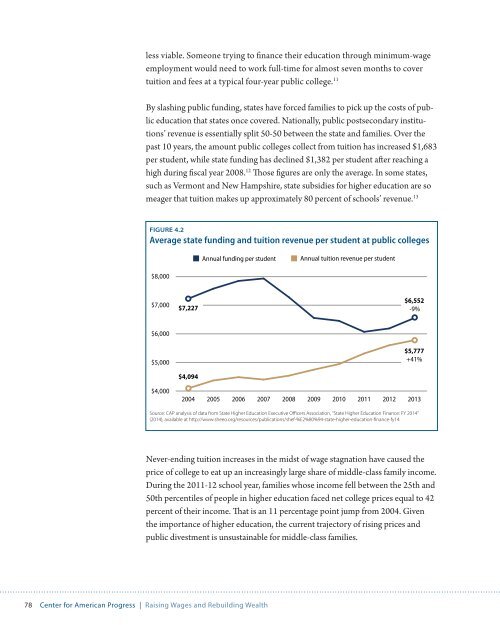AGENCY/PHOTOGRAPHER
RaisingWagesRebuildingWealth
RaisingWagesRebuildingWealth
You also want an ePaper? Increase the reach of your titles
YUMPU automatically turns print PDFs into web optimized ePapers that Google loves.
less viable. Someone trying to finance their education through minimum-wage<br />
employment would need to work full-time for almost seven months to cover<br />
tuition and fees at a typical four-year public college. 11<br />
By slashing public funding, states have forced families to pick up the costs of public<br />
education that states once covered. Nationally, public postsecondary institutions’<br />
revenue is essentially split 50-50 between the state and families. Over the<br />
past 10 years, the amount public colleges collect from tuition has increased $1,683<br />
per student, while state funding has declined $1,382 per student after reaching a<br />
high during fiscal year 2008. 12 Those figures are only the average. In some states,<br />
such as Vermont and New Hampshire, state subsidies for higher education are so<br />
meager that tuition makes up approximately 80 percent of schools’ revenue. 13<br />
FIGURE 4.2<br />
Average state funding and tuition revenue per student at public colleges<br />
Annual funding per student<br />
Annual tuition revenue per student<br />
$8,000<br />
$7,000<br />
$7,227<br />
$6,552<br />
-9%<br />
$6,000<br />
$5,000<br />
$4,000<br />
$4,094<br />
2004<br />
$5,777<br />
+41%<br />
2005 2006 2007 2008 2009 2010 2011 2012 2013<br />
Source: CAP analysis of data from State Higher Education Executive Officers Association, “State Higher Education Finance: FY 2014”<br />
(2014), available at http://www.sheeo.org/resources/publications/shef-%E2%80%94-state-higher-education-finance-fy14.<br />
Never-ending tuition increases in the midst of wage stagnation have caused the<br />
price of college to eat up an increasingly large share of middle-class family income.<br />
During the 2011-12 school year, families whose income fell between the 25th and<br />
50th percentiles of people in higher education faced net college prices equal to 42<br />
percent of their income. That is an 11 percentage point jump from 2004. Given<br />
the importance of higher education, the current trajectory of rising prices and<br />
public divestment is unsustainable for middle-class families.<br />
78 Center for American Progress | Raising Wages and Rebuilding Wealth


